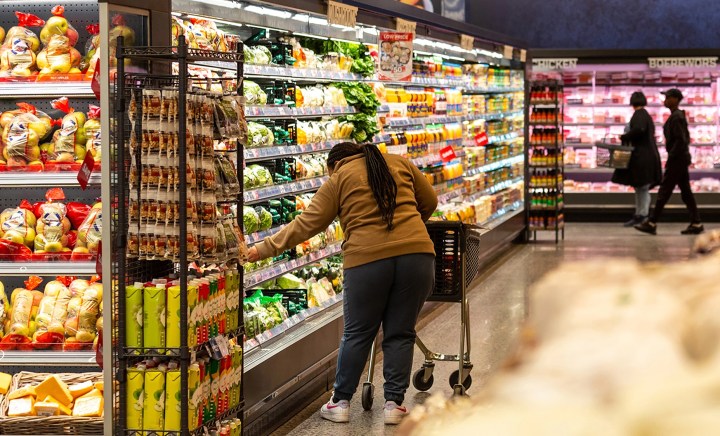BHEKISISA OP-ED
Why it’s crucial for SA supermarkets to cut prices of 10 key foods by a fifth

The food industry will get a tax break to ease the effects of load shedding on the cost of groceries. But there’s more that the industry can do to keep a basic basket of foods affordable.
Makhulu Klaas, 74, from Mdantsane, a township near East London in the Eastern Cape, is grateful for the R90 extra she’ll get each month as part of her old-age pension, announced in Finance Minister Enoch Godongwana’s budget speech last week.
Klaas lives with her daughter, who works as a cleaner, and two grandchildren, of two and 10 years, in a corrugated iron shack. On the one side, there’s a tarred road, on the other, just behind the tiny backyard of her small unfenced plot, a stream.
The R90 added to her current R1,980 in pension from April, will help Klaas to buy an extra 5kg bag of mealie meal and half a kilogram more sugar beans. These items are daily staples, which analysts include in tracking the prices of a basket of basic foods.
But while the government gives with one hand, it takes with the other.
From 1 April, electricity will cost 18.65% more, after the National Energy Regulator of South Africa approved a price hike by Eskom. Klaas’s household spends about R500 a month on electricity, which means R93 extra for lights and heating — her entire grant increase.
Mealie meal and dried beans in Klaas’s grocery basket give her family carbohydrates and some proteins — what nutrition scientists call macronutrients. But to stay healthy, people also need foods like meat or eggs, dairy products and vegetables and fruit, say the South African food-based dietary guidelines. These add important micronutrients — vitamins and minerals — to someone’s diet.
But about one in five South African households don’t have enough food on the table, 2021 statistics show, let alone spare cash to spend on things like dairy and vegetables.
Klaas at least is somewhat better off than many others in townships like hers because she can grow beans, spinach and butternut in her small backyard vegetable patch.
In many densely packed informal settlements, though, such home gardens are not viable. These areas easily become “food deserts” — places where it’s difficult to find nutritious foods but high-calorie, low-protein fast foods such as slap chips, sugary drinks and white bread are much easier to buy.
So, how should South Africa tackle the problem of getting people to eat healthy things if they have too little money to spend on food in the first place? Treasury — and the food industry — can take one more step to make food more affordable.
The quick fix
The government’s lifebuoys — such as upping the old-age pension — offer some relief.
In his budget speech, the finance minister now also included food manufacturers in the list of industries that can benefit from the diesel refund, which is already in place for primary producers such as farming, forestry and fishing businesses. This will apply until 2025 to help ease the pressure of inflation on the price of basic nutritious food items, such as maize meal, rice, eggs and amasi.
Child support grants — R480 per child per month — can fund about three-quarters of a child’s basic food needs. This support is for a parent who earns less than R4,400 a month and, according to the national budget for 2023, will be upped to R500 from April and R510 a month from October.
Covid-19 relief grants (R350 a month for people older than 18 who have no income and no other financial help from government) have proved a critical safety net over the past two years. This extra money, which will be available until March next year, spared 1.1-million children from slipping below the food poverty line — a boundary that affected 6.9-million kids in 2020. The food poverty line, which sits at R663 a month at the moment, is the least amount of money someone needs for buying food to give them enough energy for a day.
Visit Daily Maverick’s home page for more news, analysis and investigations
But these financial buffers are not enough. Stats SA estimates that in 2022 each person in a household needed R945 to live on, taking into account food, clothing and other costs. At R500 a month, this year’s child support grant will only cover about half of what is needed.
The long game
The long-term solution is to shift to a national food and agricultural policy that is designed to make healthy foods more affordable. The United Nations Food and Agriculture Organisation (FAO) says that government subsidies work best if they help consumers to buy more food.
But if primary producers such as farmers simply have to accept the prices food manufacturers and large retailers offer for their products, the plan could fail, FAO says, because it would undermine their livelihood.
South Africa’s Competition Commission has found that food manufacturers and big shopping chains have a big say in setting food prices in the country. While the profit margins on foods such as meat, dairy and chicken are fairly low, the Essential Food Price Monitoring Reports of the Competition Commission find that they still contribute substantially to retail prices. For example, in 2020, only about 30% of what retailers charged for a litre of fresh milk ended up in the farmer’s pocket, despite the farmer doing far more work to produce the milk than the store to sell it. Similarly, the August 2022 report notes that the price consumers pay for bread, and to some extent also maize, has risen faster than what retailers pay the manufacturers, which, the Commission says, suggests price-setting behaviour along the chain.
The responsibility of big manufacturers and supermarkets is not only a moral one, but a financial one too: public funding for social grants is a massive contributor to the revenue of the food retail market in South Africa, equal to 30% of total turnover. This means that taxpayers effectively subsidise part of the profits of the big supermarket chains like Shoprite, Spar and Pick n Pay.
A bold move from food manufacturers and retailers is needed to help South Africans buy nutritious food with the money they have. Being willing to waive their mark-ups on an essential basket of foods rated by the Grow Great zero-stunting campaign as the “10 best buys”, including eggs, speckled beans, pilchards and peanut butter — if government finances matched that commitment — will go a long way.
Based on the reports of the Competition Commission, a reasonable estimate is that such discounting by manufacturers and retailers would let the cost of the specified basket of goods drop by about 20%. A matching subsidy by government would make the basket go one-fifth further, helping to close the gap between what households need and what they earn. Together with their existing VAT exempt status, the basket price could be half of what the market might dictate.
It’s not business as usual
The initiative for a basket of discounted foods will have to come from industry. In Egypt, India and the Philippines, targeted food subsidies increased household access to food and reduced the prevalence of underweight children. In field studies in several other countries, including South Africa, retail subsidies helped people to buy healthier foods.
But it doesn’t always work. For example, in China and Iran, the support has little effect, because the subsidy, in this case, provided by the government to reduce the cost of food, was kept by the retailer and not passed on to the consumer.
If this idea is going to work, it can’t be done grudgingly. Without food retailers readily sharing information about how they determine margins on items, it’s possible that the potential of a discounted food basket to improve nutrition over the next five years may be overestimated. Moreover, times are tough also for these businesses and it’s possible that the items people choose to put in their grocery baskets may not all be healthy.
These are risks that need to be considered and for which the answers are not yet clear. But what is clear, is that it’s no longer acceptable for the food industry to excuse itself from public debate about how we confront the challenge of a nutritionally underpowered nation. MC
David Harrison is the chief executive officer of the DG Murray Trust. The Trust sees itself as a public innovator through strategic investment in early child development, education and support for young people entering the labour market.
This story was produced by the Bhekisisa Centre for Health Journalism. Sign up for the newsletter.




















 Become an Insider
Become an Insider
The leading supermarkets announce the millions in profits with pride each year: everyone is taking a hit financially but not them. Is this toxic capitalism? Or just greed and entitlement? It’s not sustainable – hunger leads to anger which creates social instability which impacts the economy and profits.
Thanks for this commentary David, however, this approach is very broad and is likely to benefit middle and upper-income consumers the most if the zero-VAT rating data is anything to go on.
In 2018, the zero VAT rating on the basket of essential food items resulted in R23.3 billion per year saving for consumers (and a loss to the national budget). On face value sounds simple and effective way to bring down food costs. However, DBO’s analysis of this 23.3 billion showed that 15.3 billion of these savings were made on spending by middle- and upper-income consumers while just R7 billion of these tax savings were experienced by the poor and very poor.
This meant that it cost the South African fiscus R23.3 billion in lost revenue to deliver R7billion in food relief to the poor and very poor. The zero-rating programme costs R3 to deliver R1 of food aid to the poor. Other retail-side initiatives that don’t target relief directly to the most in need are likely to mirror this problem. Would scrapping the Zero VAT rating system and using that fiscal surplus to triple our spending on ECD and school nutrition programmes not be a better approach?